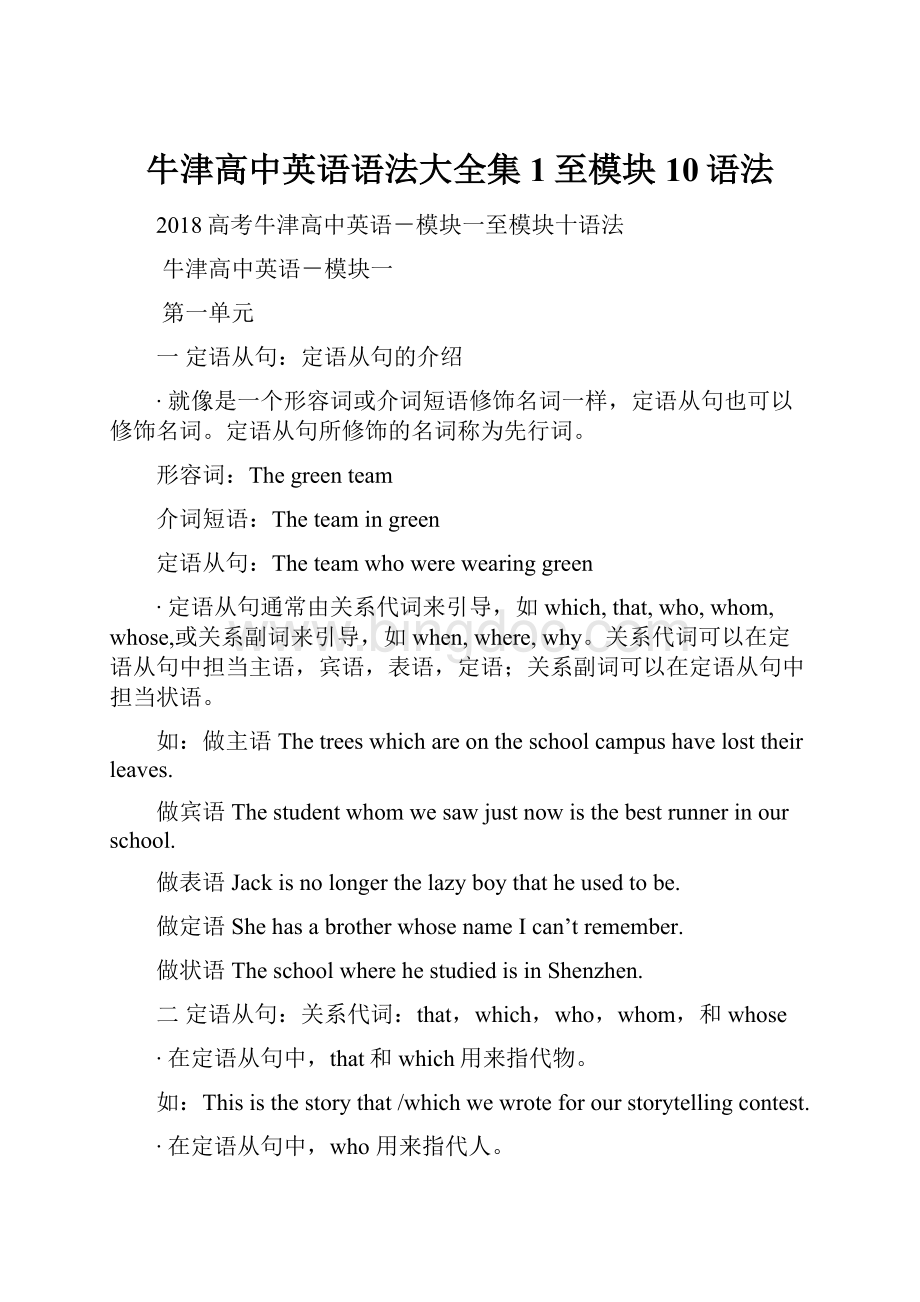牛津高中英语语法大全集1至模块10语法.docx
《牛津高中英语语法大全集1至模块10语法.docx》由会员分享,可在线阅读,更多相关《牛津高中英语语法大全集1至模块10语法.docx(62页珍藏版)》请在冰点文库上搜索。

牛津高中英语语法大全集1至模块10语法
2018高考牛津高中英语-模块一至模块十语法
牛津高中英语-模块一
第一单元
一定语从句:
定语从句的介绍
∙就像是一个形容词或介词短语修饰名词一样,定语从句也可以修饰名词。
定语从句所修饰的名词称为先行词。
形容词:
Thegreenteam
介词短语:
Theteamingreen
定语从句:
Theteamwhowerewearinggreen
∙定语从句通常由关系代词来引导,如which,that,who,whom,whose,或关系副词来引导,如when,where,why。
关系代词可以在定语从句中担当主语,宾语,表语,定语;关系副词可以在定语从句中担当状语。
如:
做主语Thetreeswhichareontheschoolcampushavelosttheirleaves.
做宾语Thestudentwhomwesawjustnowisthebestrunnerinourschool.
做表语Jackisnolongerthelazyboythatheusedtobe.
做定语ShehasabrotherwhosenameIcan’tremember.
做状语TheschoolwherehestudiedisinShenzhen.
二定语从句:
关系代词:
that,which,who,whom,和whose
∙在定语从句中,that和which用来指代物。
如:
Thisisthestorythat/whichwewroteforourstorytellingcontest.
∙在定语从句中,who用来指代人。
如:
IamgoingtoseeafriendwhohasjustcomebackfromtheUK.
∙当who在定语从句中做宾语时,可以用whom来取代,且whom比who更正式。
如:
Idon’tknowthenameoftheteacherwho/whomIsawinthecomputerroomtheotherday.
∙当关系代词在定语从句中做宾语时,who,whom,which和that可以被省略。
如:
Helikesallthebirthdaypresents(that/which)hisfriendsgavehim.
∙Whose用来表示所属,它既可指人也可指物。
如:
IsatnexttoagirlwhosenamewasDiane.
TheclubwhosemembersaremusicfansmeetintheschoolgardeneverySaturdayafternoon.
第二单元
一定语从句:
介词提前的定语从句(preposition+which;preposition+whom)
∙当关系代词(which/whom)做定语从句中介词的宾语时,可以把介词提到关系代词的前面。
如:
Wethoughtyouwereapersonfromwhomwecouldexpectgooddecisions.
∙在非正式英语中,介词通常放在定语从句的最后。
如:
ArtisthesubjectwhichIknowlittleabout.
∙如果介词放在定语从句的最后,which可以被that取代,whom可以被that和who取代。
如:
Dadisapersonwhom/that/whoIcaneasilytalkto.
∙当关系代词做定语从句中介词的宾语,并且介词又放在定语从句的末尾时,我们通常省略关系代词who和that。
如:
Thetopic(which)EricisinterestedinisPhysics.
Danielistheperson(whom)Iwanttomakefriendswith.
∙当先行词是way时,我们用inwhich或that来引导定语从句,这种情况下,inwhich或that可以被省略。
如:
Ididn’tliketheway(that/inwhich)shetalkedtome.
二定语从句:
关系副词:
when,where,why
1.我们通常用关系副词when引导先行词是time,moment,day,season,year等的定语从句。
如:
Doyourememberthedaywhenweleftyouincharge?
IoftenthinkofthemomentwhenIsawtheUFO.
2.我们通常用关系副词where引导先行词是place,house,city,country,city,world等的定语从句。
如:
Thepolicesearchedthehousewherethethiefhadstayed.
Thisisnotafamilywherebadbehaviorgoesunpunished.
3.我们通常用关系副词why引导先行词是reason的定语从句。
如:
Idon’tknowthereasonwhythehouseissodirty.
4.在更加正式的英语中,where,when和why能够被介词+which所替代。
如:
Thestudyistheplacewhere/inwhichIoftenhavetalkswithmyfather.
Thisisthereasonwhy/forwhichmyparentsgothomeearlier.
Itrainedthewholedaywhen/onwhichhetraveledwithhisfamily.
第三单元
一定语从句:
非限制性定语从句
1.非限制性定语从句是一个为主句添加额外信息的从句,在非限制性定语从句前通常有个逗号。
如:
Amy,whotookweight-losspills,nowrealizesthathealthisimportant.
Mypillsareinthebathroom,whereIalwayskeepthem.
2.当先行词是整个主句时,可以用which来引导定语从句。
如:
Hemissedtheshow,whichwasagreatpity.
3.我们可以用all+whom/which来表示全部数量,用someof+whom/which来表示部分数量。
如:
Iamdoingdifferenttypesofexercises,allofwhicharequitehelpfultomyhealth.
Manypeople,someofwhomarenotoverweight,aregoingondiet.
二附加疑问句
1.附加疑问句是放在陈述句后面的短问句。
它们通常被用在口语中来引出一段对话,以一个更加礼貌的方式来询问信息,温柔的发号施令或要求某人做某事。
我们用附加疑问句来询问意见或征求同意。
当我们用附加疑问句来询问意见时,为了期待对方能同意我们的观点,附加疑问句会用降调来表达。
当我们用附加疑问句来征求同意时,我们实际上是在询问我们自己也不太能确信的事情,这时候附加疑问句会用升调来表达。
2.附加疑问句的构成有以下几种:
1)在肯定的陈述句之后,我们会用否定的附加疑问句。
在否定的陈述句之后,我们会用肯定的附加疑问句。
如:
Wecanstillbefriends,can’twe?
Hedoesn’tlikeicecream,doeshe?
∙当主句中有像neither,none,nobody,nothing,few,little,never,hardly或seldom这类词时,它们被认为是否定的,因此后面会跟个肯定的附加疑问句。
如:
Neitherofyouwillhavecoffee,willyou?
NoonehasfoundmyCD,havethey?
Nobodyunderstoodhisspeech,didthey?
Hissisterseldomargueswithpeople,doesshe?
∙人称代词如I,we,you,he,she,it或they会放在附加疑问句中。
如:
Iwasprettysilly,wasn’tI?
Everyonehasadvisesyounottogoonadiet,haven’tyou?
∙助动词,情态动词或be动词会放在附加疑问句中。
如:
Youliketraveling,don’tyou?
Thereissomethingwrong,isn’tthere?
Youcan’tspeakItalian,canyou?
∙祁使句后用willyou,Let’s后用shallwe
如:
Postaletterforme,willyou?
Let’shaveabreak,shallwe?
牛津高中英语-模块二
第一单元
一现在完成时态
1.我们用现在完成时态来表示在最近的过去发生的但跟现在有联系的事情。
如:
ThedisappearanceofJustinhasmadeKellyveryunhappy.
2.我们也用现在完成时态来表示在过去刚开始,并且现在还没结束的事情。
如:
IhavenotseenJustinsincelastFridaynight.
∙当动作发生的确切时间不清楚或不重要时,我们也用现在完成时态。
经常连用的时间短
语有:
alreadyeverforjustlatelyneverrecentlysinceyet
already用语肯定句,yet用语否定句。
如:
Theboyhasalreadycomehome.Ihaven’theardanythingfromhimyet.
for+一段时间since+点时间
如:
Wehaven’tseenhimfortwoyears.Wehaven’tseenhimsince2002.
注:
当已给定具体的时间时,我们往往用一般过去时态,而不是现在完成时态。
∙我们用现在完成时态来谈论刚刚完成的动作。
如:
Thepolicehavejustfinishedsearchingthearea.
∙我们也用现在完成时态来表示重复的动作。
如:
SomevillagessaythattheyhaveseenUFOsmanytimes.
∙现在完成时态的构成是:
have/has+动词的过去分词
二现在完成进行时态
1.我们用现在完成进行时态来表示在过去发生的并且仍将继续的动作。
如:
IhavenotbeensleepingwellsinceIreturnedhome.
2.我们用现在完成进行时态来表示刚刚结束但以某种方式和现在有联系的动作。
如:
---SorryI’mlate.Haveyoubeenwaitinglong?
---Yes,I’vebeenwaitingforanhour.
3.现在完成进行时态的构成:
have/has+been+doing
注:
for和since和现在完成进行时态连用。
如:
Ihavebeenwaitingforalongtime.
Hehasbeenwaitingsincenineo’clock.
三现在完成时态还是现在完成进行时态
1.我们用现在完成时态来谈论刚刚完成的动作,用现在完成进行时态来表示发生在过去并且现在仍在发生的动作。
如:
LiJiahasreadabookaboutStonehenge.(Shefinishedreadingthebook.)
LiJiahasbeenreadingabookaboutStonehenge.(Sheisstillreadingthebook.)
2.我们用现在完成时态表示重复的动作,用现在完成进行时态来表示不停的动作。
如:
IhavevisitedEgypttwicethismonth.
IhavebeentouringEgyptfortwomonths.
现在完成时态用于回答howmany/much的提问,现在完成进行时态用语回答howlong的提问。
如:
Howmanytimeshaveyouswuminthelake?
Howlonghaveyoubeenswimminginthelake?
3.状态动词和动作动词都可以用在现在完成时态中,但只有动作动词可以用在现在完成进行时态中。
如:
Ihavehadthiscameraforfiveyears.(状态动词)
IhavetakenphotosofUFOwiththiscamera.(动作动词)
IhavebeentakingphotosofUFOwiththiscamera.(动作动词)
注:
动作动词表示发生或变化的动作,如go,play。
状态动词表示保持不变的动作,如like,know,exist
4.当never,yet,already,ever出现在句子中时,只用现在完成时态,而不用现在完成进行时态。
如:
I’venevervisitedParis.
I’vealreadybeentoParis.
第二单元
一将来进行时态
1.我们用将来进行时态来:
1)谈论将来一段时间正在进行的事情。
如:
TobywillbeclimbingintheHimalayasallnextweek
2)谈论从将来的某一点开始并且有可能要持续一段时间的事情。
如:
TobywillnotbeinLondonnextTuesday.HewillbeclimbingintheHimalayas.
3)没有任何意图的表达将来的事情。
如:
TheweatherreportsaysthatitwillberainingwhenwearriveinLondon.
在这种情况下表示事情是很自然的发生的,没有人为的安排。
4)礼貌地询问有关其他人将来的计划。
如:
WillyoubevisitingyouruncleinTanzania?
2.将来进行时态的构成:
1)陈述句:
will(not)+v-ing
如:
Tobyandhisbrother,Colin,will(not)beflyingtoMorocco.
2)疑问句:
will提到主语的前面
如:
WilltheybeflyingtoMoroccoon15thJuly?
3)回答:
will(not)
如:
Yes,theywill./No,theywillnot(won’t)
二过去将来时态
1.我们用过去将来时态和过去进行时态来:
1)表示过去的将来某一时间要发生的动作。
如:
Theysetoffat9a.m.andwouldreachtheairportanhourlater.
2)暗指一个过去的目的。
如:
Iwasgoingtoleave,butthenitrained.
3)暗指一个过去的安排。
如:
ColincalledJennifertosaythathewasseeingherlaterthatafternoon.
4)指代实际已经发生过的将来的动作。
如:
ThejourneythatwastochangeToby’slifestartedinJulythatyear.
2.陈述句中过去将来时态的构成:
1)would+动词原形
如:
ItoldyouColinandIwouldspendafewweekstraveling.
2)was/weregoingto,was/wereto,was/wereaboutto
如:
Weweregoingtoseethewildanimals,butthenwedidn’thavetime.
Itwashislastdayatschool---hewastoleavethenextmorning.
Colinwasabouttogetoffthecamelwhenachildrantowardshim.
第三单元
一过去完成时态
1.我们用一般过去时态来谈论一个过去的动作。
当我们想要谈论比过去更早的时间里发生的事情时,就用过去完成时态。
如:
Uponenteringthetomb,Carter’sluckypetbird,whichhadledhimtotheplace,waseatenbyasnake.
2.在直接引语中,我们用过去完成时态来指代说话的时候就已经发生的动作。
直接引语中的一般过去时态和现在完成时态在间接引语中改为过去完成时态。
如:
“Weemptiedthetombofeverythingitcontained,”saidCarter.-------
Cartersaidthattheyhademptiedthetombofeverythingitcontained.
3.过去完成时态只是指在另一个过去的动作之前发生的动作,并不是指发生在一长段时间以前的动作。
如:
IhaddonemyhomeworkthismorningbeforeIwenttothemuseum.
4.过去完成时态经常跟以下引导的时间短语连用,如when,after,before,assoonas,until,since,by,for,already.
如:
ThenafewmonthsafterCarterhadopenedthetomb,LordCarnarvonfellillwithafeveranddied.
5.过去完成时态的构成:
had+v-ed
如:
HowardCarterhadreceivedmoneyfromLordCarnarvonbeforehemadehismostamazingdiscovery.
二现在完成时态还是过去完成时态
当我们谈论一个与现在有关的过去的事情时,我们用现在完成时态。
如:
HowardCarterisoneofthemostfamousexplorerstheworldhaseverknown.
当我们在谈论过去,并要说明一个更早发生的动作的时候,我们就要用过去完成时态。
如:
Notlongafterthetombhadbeenopened,peopleinCarter’steambegantofallillanddiestrangly.
牛津高中英语-模块三
第一单元
一名词性从句:
名词性从句的介绍
名词性从句在句中的作用和名词或名词短语的作用是一样的。
∙我们可以用名词性从句做句子的主语。
如:
ThatIcanpaybackthehelppeoplegivememakesmehappy.
Whetherhe’llbeabletocomeisnotyetknown.
Whytheyhavenotleftyetisunclear.
我们可以用it来做形式主语。
如:
Itwasgoodnewsthateveryonegotbacksafely.
∙我们可以用名词性从句来做动词的宾语。
如:
shesensedthatshewasbeingwatched.
Iwonderif/whetherthat’sagoodidea.
Pollydidn’tknowwhichwaysheshouldgo.
我们可以用名词性从句来做介词的宾语。
如:
I’minterestedinwhothattallmanis.
TherewasadiscussionaboutwhetherPollyhadfoundtheblindman.
我们可以用it来做形式宾语。
如:
weallthoughtitgoodnewsthatthefoghadfinallygone.
Theconductorhasmadeitclearthatnobuseswillberunning.
∙我们可以用名词性从句来做表语。
如:
thetruthisthatthefogistoothinkforthebustorunthatfar.
MyquestioniswhetherPollycanfindherwayhome.
TheproblemishowPollyisgoingtofindusinthecrowd.
∙我们可以用名词性从句来做一个名词的同位语。
如:
thefactthatPollydidn’taskfortheman’snameisapity.
Thenewsthattheplanehadcrashedmadeussad.
WhatevergaveyoutheideathatIcansing?
∙我们用that,if/whether或一个疑问词来引导名词性从句。
如:
IhopethatPollywillbeOK.
Nooneknewif/whetherhelosthissightbecauseofanaccident.
Shecouldn’timaginehowtheblindmanhadfoundher.
二名词性从句:
用that或if/whether引导的名词性从句
1.我们用that来引导名词性从句。
1)当从句是一个陈述句时,我们用that来引导名词性从句。
如:
Shesensedthatshewasb